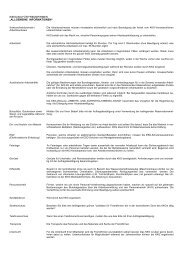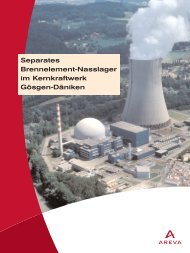Technology and Operation - Kernkraftwerk Gösgen
Technology and Operation - Kernkraftwerk Gösgen
Technology and Operation - Kernkraftwerk Gösgen
Create successful ePaper yourself
Turn your PDF publications into a flip-book with our unique Google optimized e-Paper software.
Safety precautions<br />
extreme external impact involving the failure<br />
of the switchgear building, the turbine building,<br />
the reactor auxiliary building, the water<br />
supply <strong>and</strong> the third-party supply. The feedwater<br />
system, the start-up <strong>and</strong> shutdown system,<br />
the emergency feed system <strong>and</strong> the special<br />
emergency system have a total of eleven<br />
pumps at their disposal for supplying the<br />
steam generators. A single pump is sufficient<br />
to ensure the removal of the residual heat.<br />
The special emergency building is split into<br />
two separate sections. Each of these sections<br />
houses a train of the special emergency system.<br />
The building is designed in such a way<br />
that the special emergency system is protected<br />
against external impacts, including aircraft<br />
crashes, sabotage, fires <strong>and</strong> earthquakes.<br />
Each train of the special emergency<br />
system comprises a feedwater system, a<br />
residual heat removal system, an additional<br />
boron-injection system <strong>and</strong> well pumps, an<br />
emergency power system, 48V batteries,<br />
rectifiers, a reactor protection system, a demineralised<br />
water tank with a capacity of 500<br />
cubic metres, <strong>and</strong> an emergency diesel generator.<br />
From each emergency feed pump,<br />
there is a feed line to a steam generator. To remove<br />
the residual decay heat, demineralised<br />
water is fed into at least one steam generator.<br />
The water evaporates, <strong>and</strong> the steam is released<br />
into the atmosphere through the main<br />
steam safety valves. The residual decay heat<br />
can be removed over a period of ten hours,<br />
without need for intervention by the operating<br />
staff. The structural enclosure <strong>and</strong> physical<br />
separation of the redundant sub-systems provide<br />
protection against extensive impacts,<br />
such as fire, flooding or even an aircraft crash.<br />
The electrical cabling <strong>and</strong> cooling water pipes<br />
are laid in separate locations, for example,<br />
<strong>and</strong> the instrumentation <strong>and</strong> control system<br />
lines are positioned in different sections of the<br />
switchgear building.<br />
In some cases, application of the fail-safe<br />
concept provides additional protection. Wherever<br />
possible, the safety systems are designed<br />
in such a way that malfunctions or the<br />
loss of the power supply will trigger appropriate<br />
safety-related actions. The fail-safe concept<br />
has been implemented, inter alia, in the<br />
reactor emergency shutdown system, which<br />
remains effective even if power is lost. The<br />
control rods are attached to the drive mechanism<br />
by means of electromagnets. If the<br />
power is cut off, this retaining function is lost<br />
<strong>and</strong> the force of gravity causes the rods to fall<br />
into the reactor core <strong>and</strong> shut it down.<br />
As result of the analysis of accidents abroad<br />
(Three Mile Isl<strong>and</strong> 2 <strong>and</strong> Chernobyl), special<br />
emergency measures (safety level 4) were<br />
introduced which ensure that, even for very<br />
rare accident scenarios (simultaneous multiple<br />
failure of components <strong>and</strong> equipment),<br />
the consequences for the neighbourhood of<br />
the power plant will remain limited. To protect<br />
the containment in the highly unlikely event<br />
of a beyond-design-basis incident, a filtered<br />
containment venting system was installed in<br />
1993. Through controlled <strong>and</strong> filtered venting,<br />
this system prevents containment failure due<br />
to excess pressure. The system is activated by<br />
opening the isolation valves <strong>and</strong> assures an<br />
effective retainment of aerosols <strong>and</strong> iodine in<br />
the scrubbing fluid. The separation efficiency<br />
for coarse <strong>and</strong> fine aerosols is in excess of<br />
99.9 % <strong>and</strong> for elemental iodine, in excess of<br />
99.5 % percent.<br />
Reactor protection system<br />
The reactor protection system (safety level 3)<br />
monitors the state of the reactor by measur-<br />
� � � � �26 � � � � � � � � � � � � � � � � � � � � � � � � � � � � � � � � � � � � � � � � � � � � � � � � � � � �




